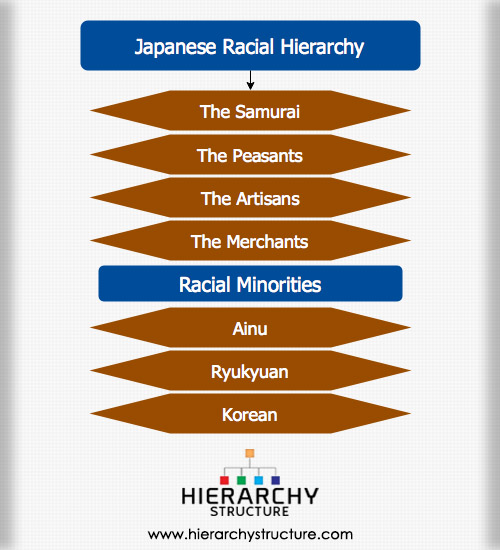Japanese constitution states that there will be no political, social and other discrimination based on the issue of race, but the Japanese society seems to be quite hierarchical in nature, where some races have a better standing, at least as far as social prestige go, than the others. Between 12th century and 19th century, Japan had the 4 tier social system. However, there were some people above and below the 4 tiers.
Racial minorities and the geishas stood at the lower ranks of the society. At the top of the society were the emperors, the daimyos etc. Later with the abolition of the feudal society, the professional class of samurais ceased to exist, but the racial hierarchy continued, with the Japanese belonging to the upper rank.
In The feudal period, Japanese society had a 4 tier hierarchical structure, consisting of
- The Samurai
- The peasants
- The artisans
- The merchants

The Samurai
Samurais are the warrior group that dominated the social structure of the feudal Japanese society. They were only 10% of the total population but held tremendous power along with their daimyo over lords, who were above the 4 tiered structures.
The Peasants
Right next to the samurais, in the hierarchical set up, was the peasants. The Confucian philosophy claims that the peasants belong to a higher rank than the artisans or the merchants, because peasants are the people who produce food for the society as a whole.
The Artisans
In the third step of the social ladder stood the artisans. They lived in the main cities, segregated from both the samurais and the merchants. Even the sword makers of the samurais were considered as lower class than the peasants.
The Merchants
The merchants belonged to the last section of the societal ladder. In traditional Japanese society, merchants were considered parasites, as it was believed that they live off the production of peasants and artisans.
Above this hierarchy was the emperor, the shogun and the daimyos. The shogun was the most powerful military ruler. And below this hierarchy were the ethnic group. Even in the modern period, the ethnic groups stand at the lower ranks of the ladder. Some of the racial minorities are as follows.
- Ainu- They are an indigenous group of people who mainly live in Hokkaido. In the Meiji period, the Japanese government attempted to absorb the Ainu people in the mainstream of Japanese society, but in the process outlawed their language. Some of the Ainus were also treated like slaves in the Japanese fishing industries.
- Ryukyuan- The Ryukyuan people lived in an independent place but in the year 1609, the land became a part of the Satsuma domain. At present, they are the largest minority group in Japan and a majority of them live in Okinawa.
- Korean- The permanently residing Koreans of Japan are known as Joseon or of south Koran origin. Most of them came to Japan during the colonial period.
There are some other racial minorities to in the Japanese hierarchical set up.
